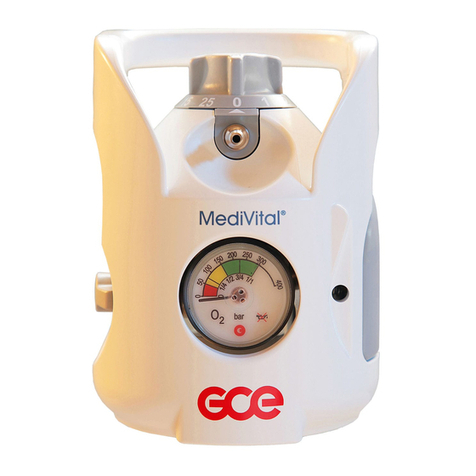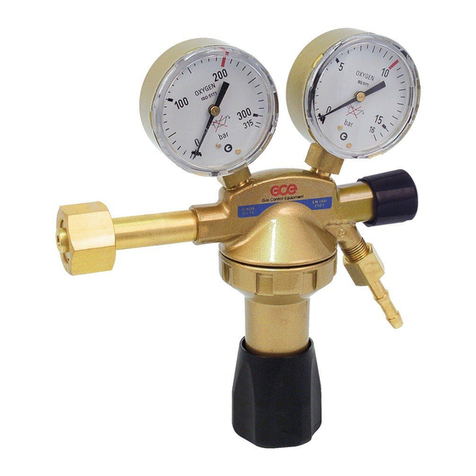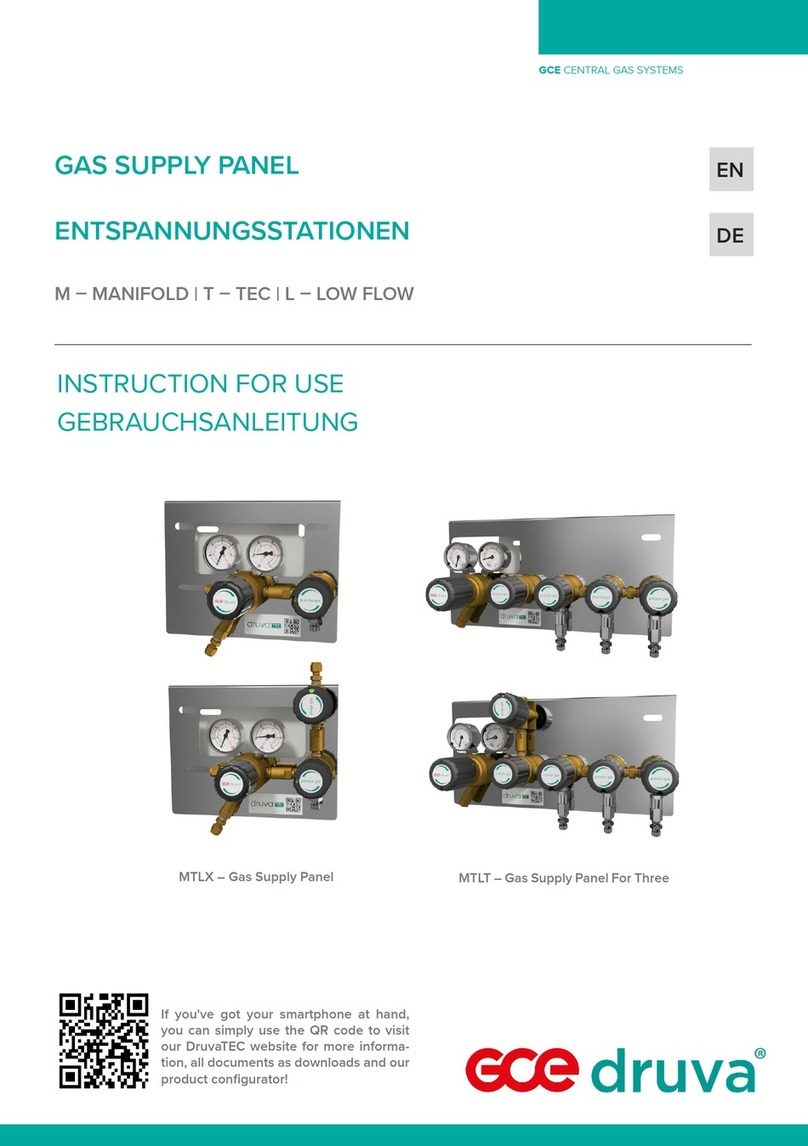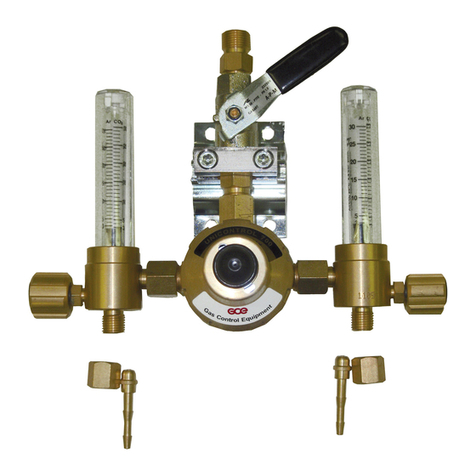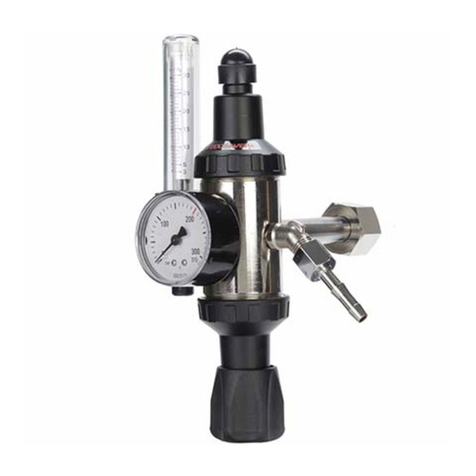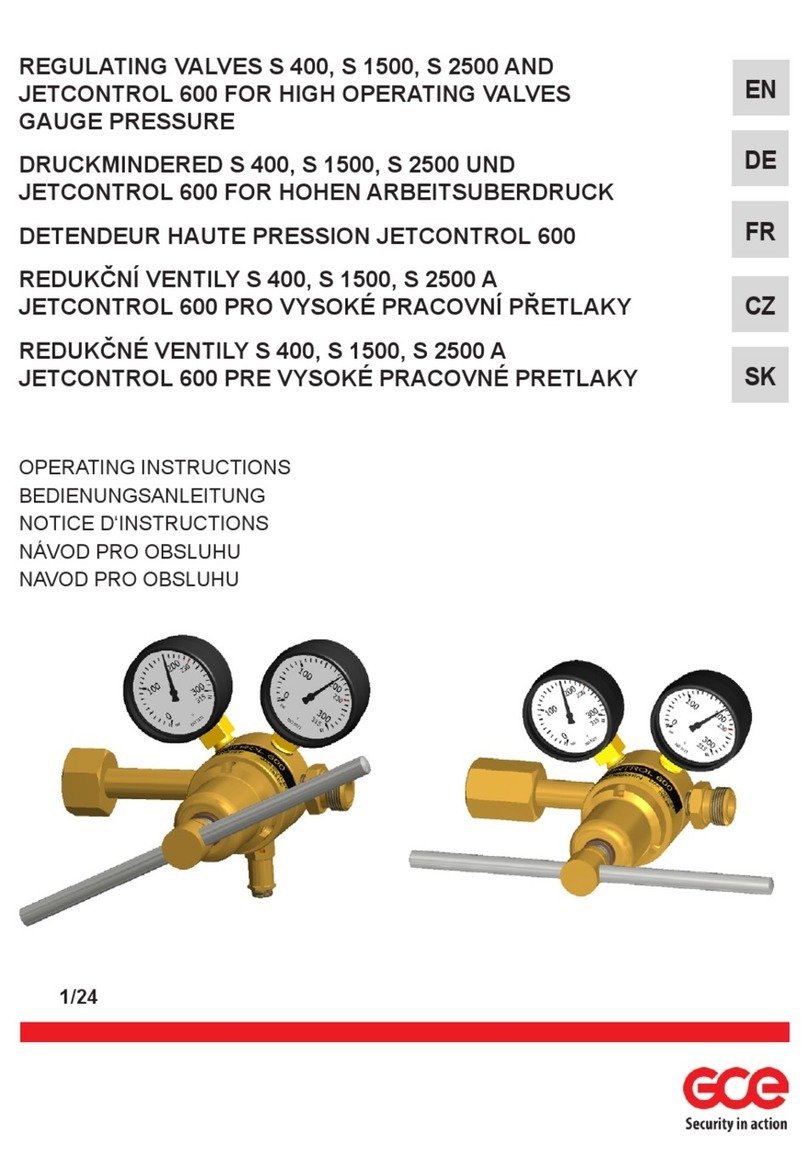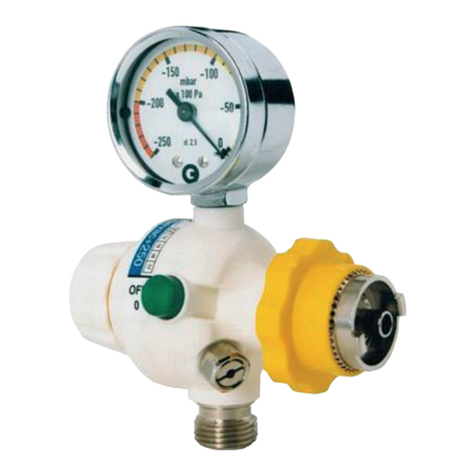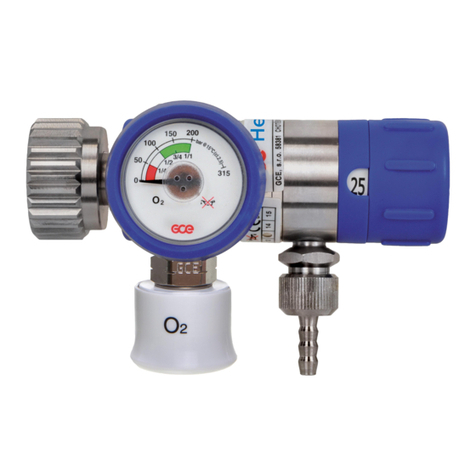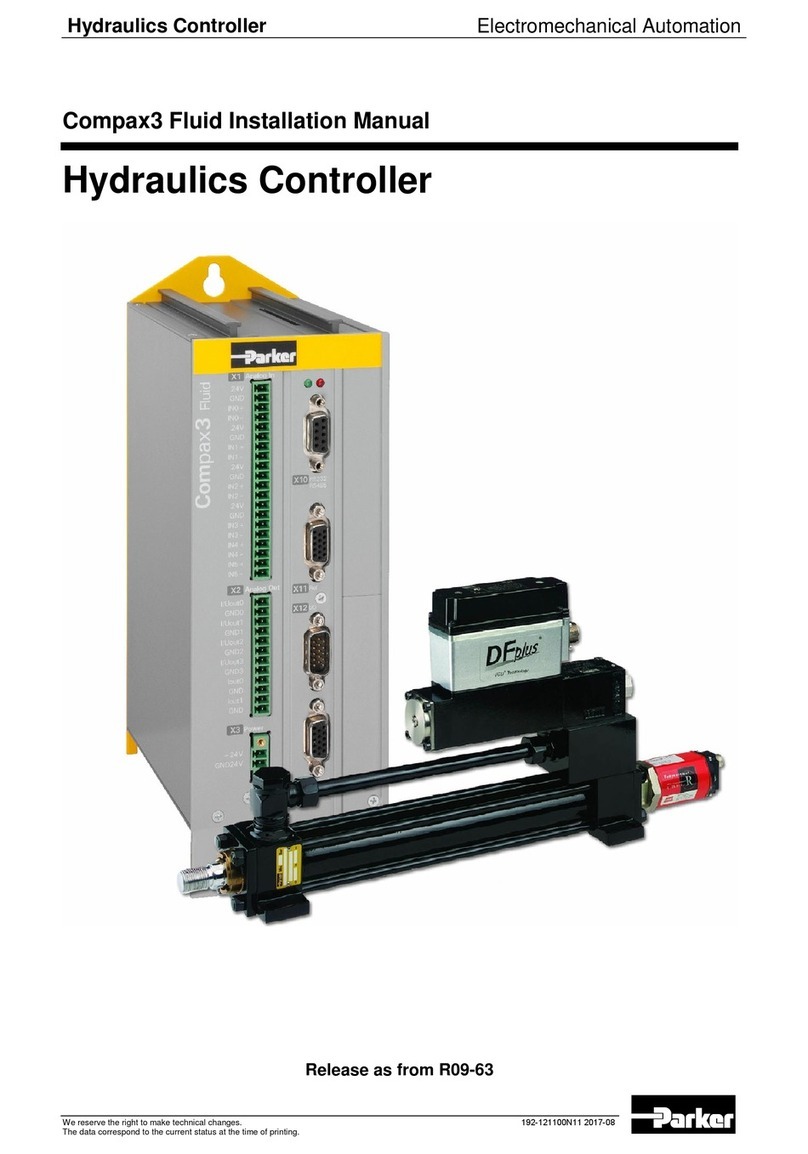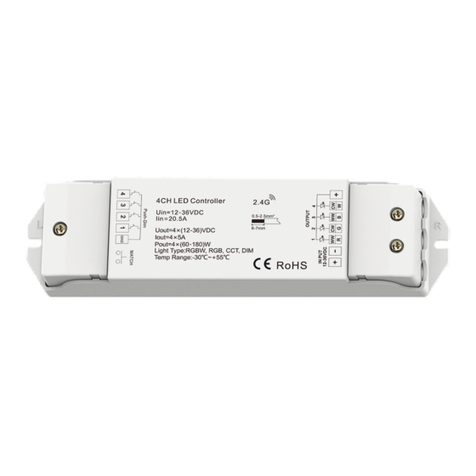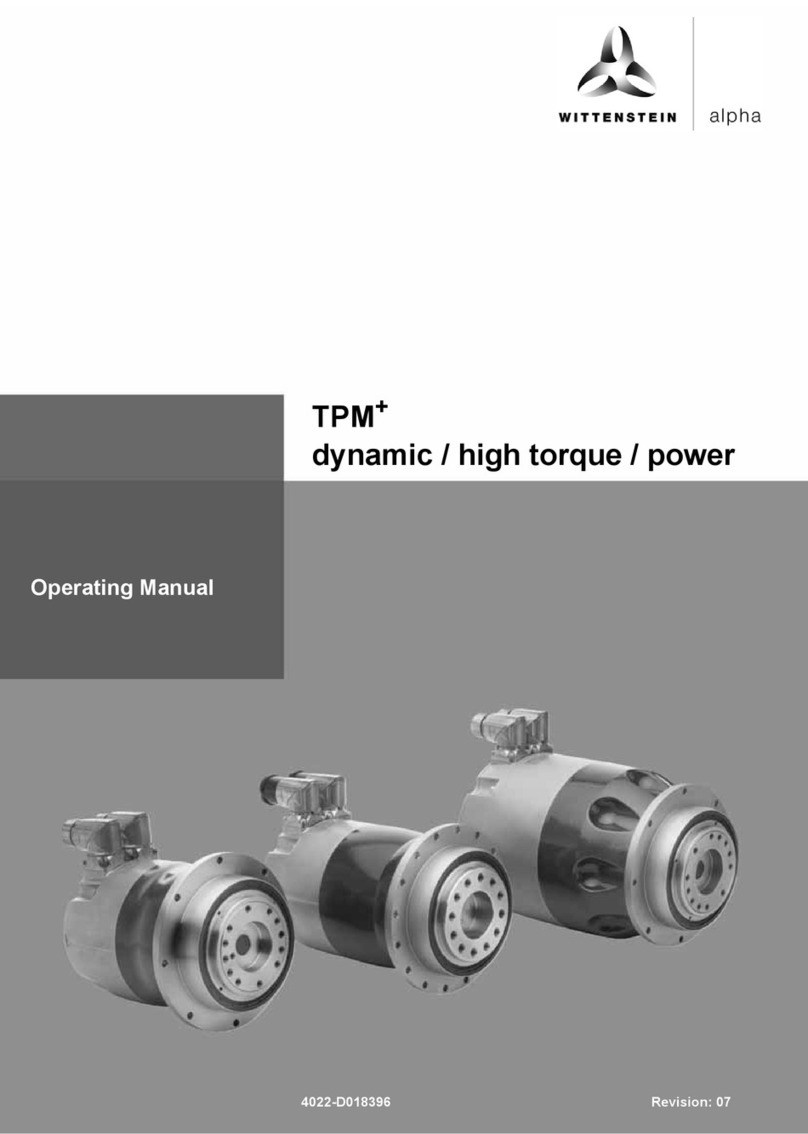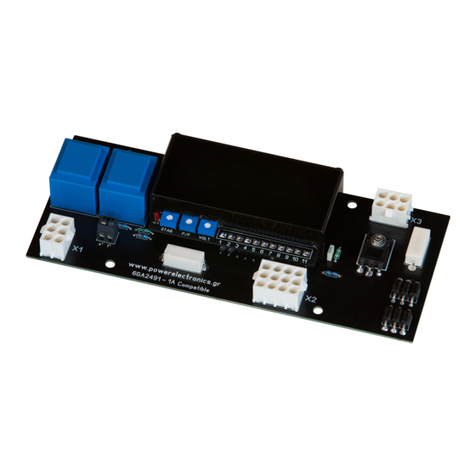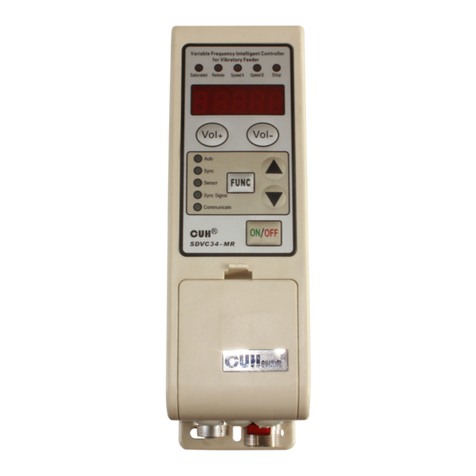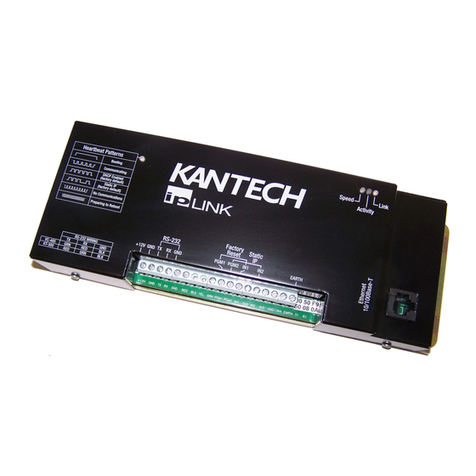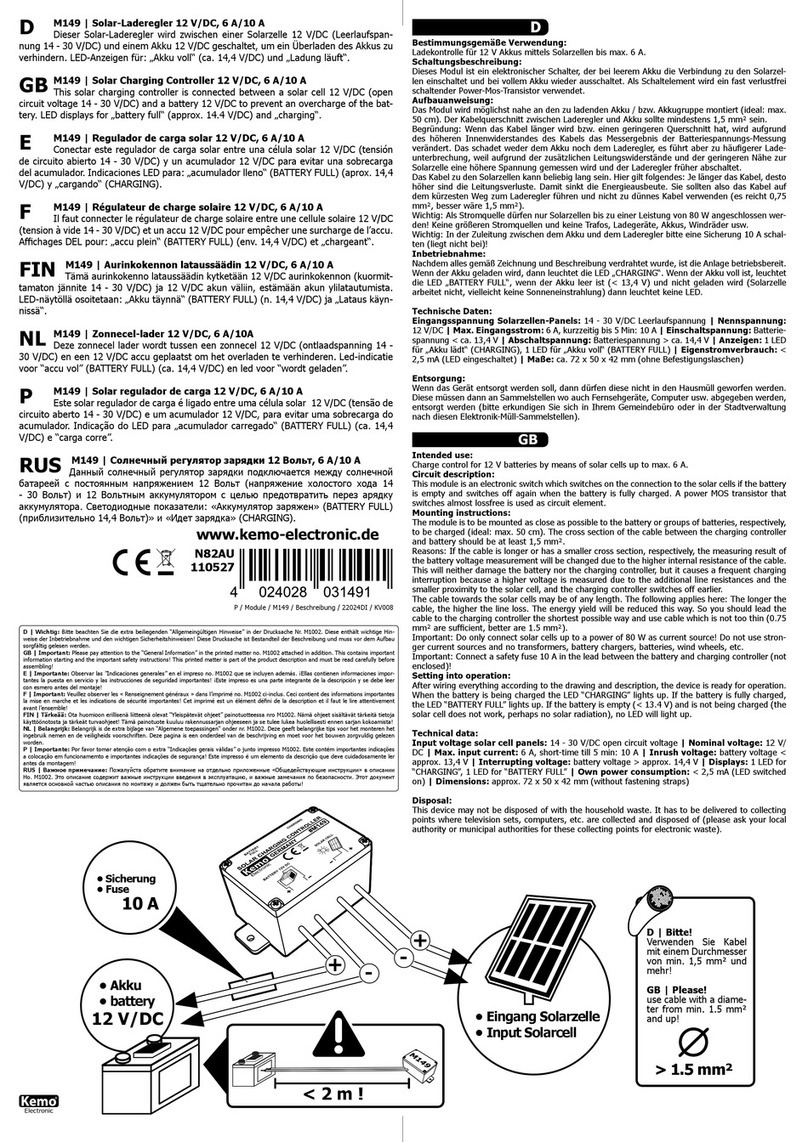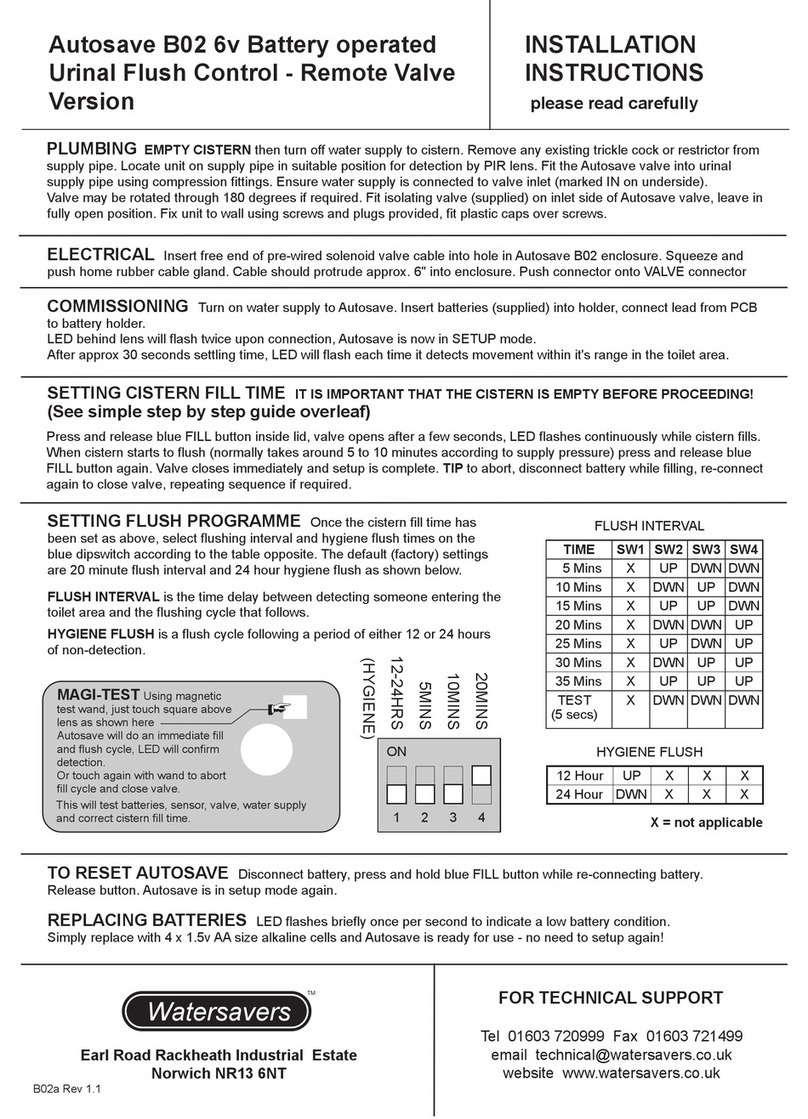GCE MediVitop User manual

INSTRUCTION FOR USE
BEDIENUNGSANLEITUNG
MODE D‘EMPLOI
INSTRUCCIONES DE USO
ISTRUZIONI D´USO
NÁVOD K POUŽITÍ
GCE VALVES
PRESSURE REGULATORS INTEGRATED
WITH CYLINDER VALVE
DRUCKREGLER MIT FLASCHENVENTILEN
EN
DE
MediVitop®
DETENDEURS INTEGRES
REGULADORES DE PRESIÓN INTEGRADOS
CON VÁLVULAS DE BOTELLA
FR
ES
RIDUTTORE DI PRESSIONE INTEGRATO CON VALVOLE
PER BOMBOLA
REDUKČNÍ VENTILY S INTEGROVANÝM
UZAVÍRACÍM VENTILEM PLYNOVÝCH LAHVÍ
IT
CS

2/59
EN
1. FOREWORD
The product complies with essential requirements of 93/42/EEC Medical Device Directive and
2010/35/EU Transportable Pressure Equipment Directive.
The valve is designed according to EN ISO 10524-3 standard.
2. INTENDED USE
MediVitop® Combination Valves are designed to be fitted to gas cylinders used for medical
gases. These combination valves together with a gas cylinder form gas packages used either
as gas supply point for medical devices (anaesthetic devices, ventilating devices, flowmeters,
suction ejectors, incubators etc.) or for direct gas supply to a patient’s breathing mask, cannula
or humidifier.
GCE Combination Valves are intended to be used with the following medical gases:
• Oxygen
• Nitrous oxide
• Air for breathing
• Helium
• Carbon dioxide
• Xenon
• Specified mixtures of the gases listed
2.1. PATIENT PROFILE
Regulator valve get gas flow from 0 to 25 liter per minutes. Information about specification flow
rate you can find in the appendix No. 1 of instruction for use. Flow rate is listed in the Appendix
No. 1 of instruction of use in the table on the position C and this Appendix is supplied to every
product.
The saturation of gas must be estimated by doctor or anesteziologic nurse. They have nec-
essary education, where they must know health status of patient and get him important gas
support.
Health status - used, when the patient will be need to support of medical gases for supporting
breathing and decision about treatment is on the side doctor or health personal.
Health personal – nurse, rescuer, paramedic, keeper or person with medical education.
2.2. USER PROFILE
Use in a hospital or in an ambulance
• Education: personal with medical education
Use in home care
Treatment is description from a doctor or personal with medical education or who set this sup-
porting of breathing
• Knowledge: training from person with medical education ability to read, study and knowl-
edge of user manual
Training is provided according to local law in individuals countries.
Important:
The patient must be trained by doctor or person, who has education on the field of safe life.
ENGLISH
INSTRUCTION FOR USE: MediVitop®

3/59
EN
3. OPERATIONAL, TRANSPORT AND STORAGE SAFETY
REQUIREMENTS
Keep the product and its associated equipment away from:
• Heat sources (fire, cigarettes,...)
• Flammable materials
• Oil or grease (take a great care in the use of hand creams)
• Water
• Dust
The product and its associated equipment must be prevented from tipping over, turning over
or falling.
Always maintain oxygen cleanliness standards.
Only use the product and its associated equipment in well ventilated area.
Before the first use the product shall be kept in its original package. If removed from service
(for transport, storage) GCE recommends using the original package (including inner packing
materials).
National laws, rules and regulations for medical gases, accident prevention and environmental
protection must be observed.
OPERATING CONDITIONS STORAGE AND TRANSPORT CONDITIONS
-20* / +65 °C -40 / +70 °C
10 / 100 % 10 / 100 %
600 / 1200 mbar 600 / 1200 mbar
*for inner tightness of the shut-o valve, during transport and storage of the combination valve
mounted on a cylinder, the valid lower temperature limit is -40°C.
In case of combination valve storage at temperature below -20°C do not use the combination
valve until its temperature reaches at least -20°C.
For the combination valves designed to be used with mixture of gases O2+N2O, the lowest
operating temperature is +5°C. In normal use of the combination valve, frosting can appear on
the combination valve surface, which is caused by the gas inside the combination valve when
high pressure in the combination valve cooling when high pressure gas is being reduced to
low pressure (Joule-Thomson eect). Check that all patient associated equipment connected
to the combination valve is via a hose of at least 2 metres length.
O2+N2O mixtures are temperature sensitive. N2O begins to separate out from the mixture if
the temperature falls below about -6°C. A homogenous mixture is again obtained when the
temperature has raised above 10°C and the cylinder was agitated. Before use, to ensure it is
properly mixed, cylinders should be stored horizontally for 24 hours at a temperature above
10°C. If this is not practicable, before use the cylinders must be maintained at a temperature
above 10°C for at least 2 hours and then completely inverted three times or placed in warm
water at body temperature for 5 minutes and then completely inverted three times.

4/59
EN
4. PERSONNEL INSTRUCTIONS
The Medical Devices Directive 93/42/EEC states that product provider must ensure that all
personnel handling the product are provided with the operating instructions & performance
data.
Do not use the product without properly familiarization of the product and its safe operation
as defined in this Instruction for use. Ensure user is aware of particular information and knowl-
edge required for the gas in use.
5. PRODUCT DESCRIPTION
Combination valve combines the function of shut-o valve of a high pressure gas cylinder and
pressure regulator for the use with medical gases. Gas from the cylinder is first controlled by
the main shut-o valve and then passed through the pressure regulator and finally delivered to
the patient through the flow outlet or the pressure outlet. Outlet positive pressure is fixed by the
manufacturer and each combination valve is provided with a low-pressure relief valve to protect
against undesirable exceeding of outlet pressure.
There are two basic alternatives:
• Valve outlet via calibrated nozzles, outlet flows can be changed by the control knob
• Valve outlet via quick-coupler (the outlet flow is a constant one) in combination with valve
outlet via calibrated nozzles where outlet flows can be changed by the control knob
K
Serial number
Inlet connection
type
Reference
number
Inlet pressure
End of
lifetime
Filling port type
Compliance with
2010/35/EU
Compliance with
93/42/EEC
MediVitop® marking detail
20 kg
Total weight
allowance of the
package
THE LAYOUT OF THE TEXT IS ONLY ILLUSTRATIVE, SOME VARIANTS MAY BE A DIFFERENT LAYOUT

5/59
EN
D
G
C
A
F
H
E
B
I
MARKING
DETAIL
J
A INLET STEM
The combination valve is fitted to gas cylinder by a threaded inlet stem. The inlet stem can
be taper threaded or parallel threaded with dierent size depending on the cylinder size and
material.
B FILLING PORT
A filling port is provided for filling the gas cylinder at a filling station, it has no function for pa-
tient use. It includes a non-return valve (NRV). The NRV means that special filling adaptors are
required to vent gas from the cylinder during the filling process (venting and/or vacuuming of
cylinders).
C INLET PRESSURE INDICATOR
Inlet pressure indicator is intended to indicate amount of gas in the gas cylinder. The pressure
indicator is of an active type which means it indicates amount of gas in the gas cylinder whether
the shut-o valve is opened or closed.
D COMBINATION CONTROL KNOB “SHUTOFF VALVE & FLOW SELECTOR“
The valve is fitted with combination control knob for valve turning-on/o and setting of particu-
lar flows. The valve is turned on by anticlockwise rotation from OFF position to ON position.
Particular flows are set by further anticlockwise rotation. The shut-o valve is turned o by
clockwise rotation to OFF position.
E RESIDUAL PRESSURE VALVE
Combination valve is equipped with a residual pres-
sure valve with function to retain a minimum positive
pressure in the gas cylinder to avoid contamination
of the cylinder content by atmospheric air. During
cylinder gas ventilation through the filling port the
residual pressure valve is by passed.
F, G FLOW CONTROL HEAD “F” AND FLOW
OUTLET “G” OPTION
Combination valve is delivered with a flow control
head “F”.This function is used to supply adjustable
gas flow rates (l/min) at atmospheric pressure direct-
ly to a patient through the flow outlet “G”, for instance
through a cannula or a facemask. Connecting the cannula

6/59
EN
The flow outlet “G“ is equipped with hose fitting (hose nipple) or a threaded type (for acces-
sories to be connected via threaded connection).
Movement of the flow outlet ‘G’ is normal due to the method of fixing in the main body. It doesn’t
indicate a faulty flow outlet.
H PRESSURE OUTLET QUICK COUPLER OR PURGE VALVE OPTION
The pressure outlet is the outlet direct from the low-pressure part of the valve and it is fitted with
a specific quick connector or purge valve.
In the use of the valve with quick connector also called ”quick coupler“ (see appendix Nr 2) the
user can connect another piece of equipment to quick coupler with a gas specific male probe
– quick-coupler probe. Its disconnection means self-sealing of the quick connector. This outlet
is for supplying gas at a controlled pressure to power medical devices, for instance medical
ventilator.
The valve without the quick coupler is provided with purge valve that is used to vent residual
pressure in the low-pressure part of the valve.
I PRESSURE RELIEVE VALVE OF LOW PRESSURE PART
Pressure relieve valve secures the low pressure part of combination valve and connected medi-
cal devices against over-pressure. If the gas pressure is decreased enough after the pressure
relieve valve activation, it will closes itself.
J EXCESS FLOW DEVICE OR DIP TUBE OPTION
Excess flow device ensures safe ventilation of gas from gas cylinder in case the combination
valve is broken above inlet stem (e.g. cylinder fall). Dip tube does not have such function. Ex-
cess flow device and dip tube are to avoid contamination from cylinder entering the combina-
tion valve.
K BED HANGER OR HUMIDIFIER HOLDER OPTION
Bed hanger enables to hang medical gas package on hospital bed. Humidifier holder enables
to connect humidifier to the combi valve.
PRESSURE RELIEVE DEVICE OF HIGH PRESSURE PART BURSTING DISC OPTION
The high pressure relieve device is intended to protect the cylinder and high pressure part of
combination valve against damage caused by increased cylinder pressure. If the pressure re-
lieve device has been activated, it will not reseal and the combination valve must be taken out
of service for repair (see Chapter 9).
Note: Colour of the product (especially guard and combination control knob) does not have
to match the gas colour coding.
6. USE OF PRODUCT
6.1. OPERATIONS PERFORMED BY USER
6.1.1. BEFORE USE
VISUAL INSPECTION BEFORE USE:
• Check the combination valve for damage (incl. label and marking). If it shows signs of external
damages, remove the product from service and suitably identify its status.
• Visually check the combination valve for contamination. If needed, apply the cleaning proce-
dure according to chapter 8.
• Check that the cylinder gas pressure indicator indicates sucient pressure. If it indicates in
the red zone, return the cylinder with combination valve back for filling.
LEAKTIGHT AND FUNCTIONAL TEST BEFORE USE:
• Open slowly the combination shut-o valve by turning slowly the combination control knob
“shut-o valve & flow selector“ in anticlockwise direction to ON position.
• By listening check for leakage (leakage would be heard as characteristic hiss of flowing gas).

7/59
EN
• Check that there is a gas flow at each “flow selector“set position in both anticlockwise and
clockwise turning direction (for instance by sound or checking presence of bubbles in a hu-
midifier)..
• Turn o at the shut-o valve by turning the combination control knob“shut-o valve & flow
selector“ in a clockwise direction to OFF position. Do not use excessive force (Maximum
recommended closing torque is 3 Nm).
• For combination valves fitted with pressure outlet, ensure it is in working condition by con-
necting and disconnecting quick-coupler probe.
If any leakage is detected, apply the procedure described in Chapter 6.2.3. and return the
valve for service.
Sudden opening could result in a danger of fire or explosion arising from oxygen pressure
shocks.
6.1.2. USE OF COMBINATION VALVE
6.1.2.1. Use of combination valve flow outlet and setting of flow
• Ensure that the accessory is connected to the flow outlet.
• Open slowly the combination control knob “shut-o valve & flow selector“ in anticlockwise
direction to ON position.
• Set the combination control knob "shut-o valve & flow selector" on one required flow rate.
Before connecting any accessory to the flow outlet make sure that the patient is not con-
nected
Sudden opening could result in a danger of fire or explosion arising from oxygen pressure
shocks.
Always ensure that the combination control knob "shut-o valve & flow selector" has been
engaged and not placed between two settings otherwise the flow control head will not deliver
correct flow of medical gas.
On flow control head, each valve is provided with so-called "end stop" located downstream
the maximum flow position. Do not try to apply excessive force on the combination control
knob "shut-o valve & flow selector" when it stops on the maximum flow position during an-
ticlockwise rotation.
Medical gas flow rate must be prescribed by a doctor.
6.1.2.2. Use of combination valve pressure outlet
• Ensure that the accessory IS NOT connected to the pressure outlet.
• Open slowly the combination shut-o valve by turning slowly the combination control knob
“shut-o valve & flow selector“ in anticlockwise direction to ON position.
• Connect the accessory to the pressure outlet.
Before connecting any accessory to the pressure outlet make sure that the patient is not con-
nected and the accessory outlet is secured.
If pressure outlet is to be connected to a medical device that requires high gas flow (for
instance pulmonary ventilator that requires gas flow 100 l/min at the minimum pressure 2.8
bar), com- pare the required flow of connecting medical device with pressure and flow char-
acteristics of the combination valve stated in appendix Nr. 1. To assure sucient performance
(pressure and flow characteristics of the combination valve ) the medical device should not be
used if pressure indicator enters the red zone.
Sudden opening could result in a danger of fire or explosion arising from oxygen pressure
shocks. Insucient opening of the shut-o valve could reduce actual flow delivered.
If a pressure outlet as well as a flow outlet are part of the combination valve do not use them
simultaneously, especially if pressure in the cylinder is below 50 bar, in could adversely aect
the outlet parameters of the combination valve .

8/59
EN
6.1.3. AFTER USE
• Turn o at the shut-o valve by turning the combination control knob“ shut-o valve & flow
selector“ in a clockwise direction to OFF position. Do not use excessive force (Maximum
recommended closing torque is 3 Nm).
• Vent pressure from the connected devices.
• Disconnect all connected devices from user outlets.
• Place the output protective caps back (if present). Ensure that the caps are clean before
replacing the caps.
7. ACCESSORIES
ACCESSORIES CONNECTABLE TO FLOW OUTLET:
• hose connected with mask, cannula or humidifier.
ACCESSORIES CONNECTABLE TO PRESSURE OUTLET:
• low pressure hose (working pressure >10 bar), flowmeters, Venturi suction ejectors, lung ven-
tilators.
OTHER USER ACCESSORIES:
• bed hanger, humidifier holder.
ACCESSORIES FOR FILLING STATIONS:
• filling adaptor.
Before connecting any accessory or medical device to the combination valve, always check
that they are fully compatible with connection features & performances of the product.
8. CLEANING
Remove dirt with a soft cloth damped in oil free soap water & rinsed with clean water. Clean-
ing of external surface can be carried out with an alcohol-based solution (with damped wipes).
If other cleaning solutions are used, check that they are not abrasive and they are compatible
with the product materials (including labels) and gas (convenient cleaning solution - i.e. Meli-
septol)
Do not use cleaning solutions containing ammonia!
Do not expose to water or any other liquid.
Do not expose to high temperature (such as autoclave).
To apply the cleaning solution do not spray it as the spray may enter into the inner parts of
combination valve and cause contamination or damage.
Do not use pressure wash as it could damage or contaminate the combination valve .
If the inner parts of the combination valve have been contaminated do not continue to use the
combination valve under any circumstances. It must be withdrawn from service.
9. SERVICE, PRODUCT LIFE TIME AND MAINTENANCE
9.1. PRODUCT LIFE TIME
Serial number and manufacture date
An eleven-figure serial number stamped on valve body consists of the data as follows:
YYYYMMXXXXX
YYYY: year of manufacture
MM: month of manufacture
XXXXX: sequence number of product

9/59
EN
For example: Serial number 20151001521 indicates the valve manufactured in 2015, in October,
with sequence number 1521.
Product life time and waste management
Maximum operating life time of this product is 15 years from date of manufacture.
At the end of the product’s life time, the product must be withdrawn from service. The provider
of the device shall prevent the reuse of the product and handle the product in compliance with
“Directive of European Parliament and Council 2008/98/EC on waste“.
In accordance to Article 33 of REACH GCE, s.r.o. as responsible manufacturer shall inform all
customers if materials containing 0.1% or more of substances included in the list of Substance
of Very High Concern (SVHC). The most commonly used brass alloys used for bodies and other
brass components contain 2-3% of lead (Pb), EC no. 231-468-6, CAS no. 7439-92-1. The lead
will not be released to the gas or surrounding environment during normal use. After end of
life the product shall be scrapped by an authorized metal recycler to ensure ecient material
handling with minimal impact to environment and health. To date we have no information that
indicates that other materials containing SVHC of concentrations exceeding 0.1% are included
in any GCE product.
9.2. REPAIR AND SERVICE OPERATIONS
Repairs and service can be only done by a GCE certified person who also holds all necessary
certificates in compliance with national standards for mounting and repair of dedicated gas
devices.
For information about a service in your area please contact GCE or distributor of GCE product.
Usually the combination valves can be repaired while fitted on the cylinder.
Repair that do not need to be done by certified personnel include exchange of the below
mentioned components:
• guard,
• labels,
• protective covers and separable hose adaptors.
All labels on the equipment must be kept in good, legible condition by the provider and the
user during the entire product life time.
Use only genuine GCE components.
Any product sent back to GCE (or GCE authorised centre) for repair or maintenance shall be
properly packaged to prevent contamination or damage during storage, transportation and
handling.
For product to be repaired, the fault short description or some reference to a claim nr. should
be indicated.
10. GLOSSARY
Consult instruction for use Suitable for Hospital care use
Caution! Suitable for Home care use
Keep away from heat and
flammable materials.
Suitable for Emergency care
use
Keep away from oil and
grease! Fragile, handle with care
Keep dry! Weight of product

10/59
EN
Humidity limit Atmospheric pressure limita-
tion
Temperature limit Use by date
Inlet parameter SN Serial number
Outlet parameter REF Catalogue number
P1Inlet pressure LOT Batch code
P2Outlet pressure REF 1 Catalogue number
Manufacturer
Take the equipment back for
recycling. Do not dispose
equipment into unsorted
municipal waste.
Date of manufacture
Do not remove any part of
the valve
11. WARRANTY
The Standard Warranty period is two years from date of receipt by the GCE Customer (or if this
is not known 2 years from time of the product manufacture shown on the product).
The standard warranty is only valid for products handled according to Instruction for use (IFU)
and general industry good practice and standards.
APPENDIX:
Nr 1: Technical and performance data
Nr 2: Quick-coupler features and connecting/disconnecting procedure
Nr 3: Post Filling Checks
Nr 4 Valve assembly and filling instruction
MANUFACTURER:
GCE, s.r.o. Tel: +420 569 661 111
Zizkova 381 Fax: +420 569 661 602
583 01 Chotebor http://www.gcegroup.com
Czech Republic © GCE, s.r.o.

11/59
DE
1. VORWORT
Das Produkt erfüllt die grundlegenden Anforderungen der Richtlinie 93/42/EWG über Medi-
zinprodukte und der Richtlinie 2010/35/EU über ortsbewegliche Druckgeräte. Das Kombiventil
erfüllt die Anforderungen der Normen EN ISO 10524-3 und EN ISO 10297.
2. ZWECKBESTIMMUNG
MediVitop® Kombiventile wurden für den Anschluss an Gasflaschen konzipiert, die für medizini-
sche Gase verwendet werden. Diese Kombiventile bilden zusammen mit einer Gasflasche eine
Einheit, die entweder als Gasquelle für Medizingeräte (Anästhesiegeräte, Beatmungsgeräte,
Flowmeter,
Absaugejektoren, Inkubatoren etc.) oder für die direkte Gaszufuhr zur Atemmaske oder Nasen-
brille eines Patienten eingesetzt werden.
Die Kombiventile von GCE sind zur Verwendung in Verbindung mit folgenden medizinischen
Gasen bestimmt:
• Sauersto, O2
• Lachgas, N2O
• Atemluft, Air
• Helium, He
• Kohlendioxid, CO2
• Xenon
• Gemische der aufgeführten Gase
2.1. PATIENTENPROFIL
Der Druchfluss ist einstellbar von 0 bis 25 Liter pro Minute. Informationen bezüglich der Durch-
flussmenge erhalten Sie in der Gebrauchsanweisung, Anhang Nr. 1. in der Tabelle, Position C.
Dieser Anhang liegt jedem Ventil bei.
Die Durchflussmenge muss von einem Arzt festgelegt werden, der den Gesundheitszustand
des Patienten kennt.
2.2. ANWENDERPROFIL
Anwendung im Krankenhaus oder in einem Rettungsfahrzeug
• Ausbildung: Personal mit medizinischer Ausbildung
Anwendung in der häuslichen Pflege
Die Behandlung wird von einem Arzt vorgegeben.
• Kenntnisse: geschult durch Personen mit medizinischer Ausbildung. Der Anwender muss mit
der Gebrauchsanweisung und den technischen Daten des Produkts vertraut sein.
Schulungen sind nach lokalem Recht der jeweiligen Länder durchzuführen.
Wichtig:
Der Patient muss von einem Arzt oder einer Person mit entsprechender Ausbildung eingewie-
sen werden.
DEUTSCH
BEDIENUNGSANLEITUNG: MediVitop®

12/59
DE
3. SICHERHEITSANFORDERUNGEN FÜR BETRIEB,
TRANSPORT UND LAGERUNGS
DAS PRODUKT UND DIE ZUGEHÖRIGEN GERÄTE SIND FERNZUHALTEN VON:
• Wärmequellen (Feuer, Zigaretten usw.),
• brennbaren Materialien,
• Ölen oder Fetten, (besondere Vorsicht: keine Handcreme verwenden,
• Wasser,
• Staub.
Das Produkt und die zugehörigen Geräte müssen gegen Umkippen, Umschlagen oder Sturz
abgesichert werden.
Es sind alle Vorschriften und Regelungen zur Sauerstoreinheit einzuhalten.
Das Produkt und die zugehörigen Geräte nur in gut gelüfteten Räumen einsetzen.
Vor Erstinbetriebnahme muss sich das Produkt in seiner Originalverpackung befinden. Im Falle
der Außerbetriebsetzung (für Transport, Lagerung) empfiehlt GCE die Originalverpackung an-
zuwenden.
Es sind die nationalen Gesetze, Regelungen und Vorschriften zu Unfallverhütung und Umwelt-
schutz beim Einsatz von medizinischen Gasen zu beachten.
ARBEITSBEDINGUNGEN LAGER UND
TRANSPORTBEDINGUNGEN
-20* / +65 °C -40 / +70 °C
10 / 100 % 10 / 100 %
600 / 1200 mbar 600 / 1200 mbar
*um die innere Dichtigkeit des Absperrventils sicherzustellen, gilt bei Transport und Lagerung
des an einer Flasche montierten Kombiventils ein unterer Temperaturgrenzwert von -40 °C.
Wird das Kombiventil bei einer Temperatur unter -20°C gelagert, darf es nicht verwendet
werden bevor wieder ein Wert von mindestens -20°C erreicht.
Für Kombiventile, die zur Verwendung mit einem Mischgas aus O2+N2O vorgesehen sind,
liegt die niedrigste Betriebstemperatur bei +5°C. Beim bestimmungsgemäßen Gebrauch
kann sich auf der Oberfläche des Kombiventils eine leichte Frostschicht ablagern. Dies wird
dadurch verursacht, dass die Temperatur des Gases durch eine Drosselung des Drucks sinkt
(Joule-Thomson-Eekt). Es ist sicherzustellen, dass alle, den Patienten betreenden Kom-
ponenten nur über einen Schlauch mit einer Mindestlänge von 2 Metern an das Kombiventil
angeschlossen werden.
O2+N2O-Gemische sind temperaturempfindlich. N2O beginnt sich aus dem Gemisch abzutren-
nen, wenn die Temperatur unter ca. -6 °C fällt. Sobald die Temperatur wieder auf über 10 °C
ansteigt und die Gasflasche gekippt wird, entsteht wieder ein homogenes Gemisch. Um vor
der Verwendung ein ordnungsgemäßes Mischen sicherzustellen, sollten die Flaschen für die
Dauer von 24 Stunden bei einer Temperatur von über 10 °C horizontal gelagert werden. Ist
dies nicht möglich, müssen die Gasflaschen vor der Verwendung entweder über mindestens
2 Stunden bei einer Temperatur von über 10 °C gelagert oder für die Dauer von 5 Minuten in
warmes Wasser (Körpertemperatur) eingetaucht und anschließend jeweils 3 Mal vollständig
gekippt werden.

13/59
DE
4. ANWEISUNGEN FÜR MITARBEITER
Gemäß Medizingeräteverordnung 93/42/EWG hat der Eigentümer des Produkts hat sicherzus-
tellen, dass alle Mitarbeiter, die mit dem Produkt umgehen, mit der Bedienungsanleitung und
den technischen Daten des Produkts vertraut sind.
Verwenden Sie das Produkt nicht, ohne dass Sie das Produkt und seinen sicheren Betrieb
kennen, wie in dieser Bedienungsanleitung angegeben. Stellen Sie sicher, dass der Benutzer
über die für das verwendete Gas erforderlichen Informationen und Kenntnisse verfügt.
5. PRODUKTBESCHREIBUNG
Das Kombiventil verbindet die Funktionen von Hochdruck-Gasflaschenventilen und medi-
zinischen Druckreglern für medizinische Gase. Das aus der Flasche austretende Gas strömt
zunächst durch das Haupt-Absperrventil, anschließend durch den Druckregler und wird
schließlich über einen Flow- oder Druckanschluss dem Patienten zugeführt. Der positive Aus-
gangsdruck ist werksseitig fest eingestellt und jedes Kombinationsventil ist zum Schutz vor
unerwünschtem Überdruck mit einem Unterdruck-Entlastungsventil ausgestattet.
Es gibt zwei grundlegende Produktvarianten:
• Ventilausgang über die kalibrierten Düsen; Ausgangsdurchflüsse können mittels Steuergerät
geregelt werden
• Ventilausgang über die Schnellkupplung (der Ausgangsdurchfluss ist konstant) in Kombina-
tion mit dem Ventilausgang über die kalibrierten Düsen, in denen die Ausgangsdurchflüsse
durch das Steuergerät geändert werden können
D
G
C
A
F
H
E
B
I
Typische MediVitop®-Ventilanordnung
KENNZEICHNUNG
J

14/59
DE
K
Seriennummer
Eingangsanschluss
Artikelnummer
Eingangsdruck
Lebensdauer
Füllanschluss
Entspricht
2010/35/EU
Entspricht
93/42/EEC
DAS LAYOUT DES TEXTES IST NUR ILLUSTRATIV, EINIGE VARIANTEN KÖNNEN
EIN ANDERES LAYOUT SEIN
A ANSCHLUSSSTUTZEN
Das Kombiventil wird mit einem Gewinde-Anschlussstutzen in die Gasflasche eingedreht. Der
Anschlussstutzen ist entweder mit einem konischen oder einem zylindrischen Gewinde aus-
gestattet und in verschiedenen Größen (für verschiedene Flaschengrößen und -materialien)
erhältlich.
B FÜLLÖFFNUNG
A Die Füllönung dient dem Füllen der Gasflasche an einer Füllstation; sie hat keine patienten-
relevante Funktion. Sie ist mit einem Rückschlagventil (NRV) ausgestattet. Das Rückschlagventil
erfordert den Einsatz spezieller Fülladapter zum Entlüften der Flasche während des Füllens
(Entlüften und/oder Evakuieren der Gasflaschen).
C MANOMETER ZUR ANZEIGE DES FLASCHENINHALTS
Dies ist ein aktives Manometer das den Flascheninhalt bei geönetem und bei geschlossenem
Absperrventil anzeigt.
D STEUERGERÄTKOMBINATION „ABSPERRVENTIL UND DURCHFLUSSWÄHLER“
Das Ventil ist mit der Steuergerätkombination zum Önen/Schließen des Ventils und zur Ein-
stellung von besonderen Durchflüssen ausgestattet. Das Ventil wird durch eine Drehung gegen
den Uhrzeigersinn von der Stellung OFF in die Stellung ON geönet. Besondere Durchflüsse
werden durch eine weitere Drehung gegen den Uhrzeigersinn eingestellt. Das Absperrventil
wird durch eine Drehung im Uhrzeigersinn in Stellung OFF geschlossen.
E RESTDRUCKVENTIL
Das Kombiventil ist mit einem Restdruckventil
ausgestattet, das einen Mindest-Überdruck in
der Gasflasche aufrechter-hält, um eine Verun-
reinigung des Flascheninhalts durch die Umge-
bungsluft zu vermeiden. Während des Füllens
der Gasflasche über den Füllanschluss wird das
Restdruckventil überbrückt.
F, G FLOWREGLER „F“ UND FLOWAN
SCHLUSS „G“ OPTIONAL
Das Kombiventil ist mit einem Flow-Regler „F“
erhältlich. Diese Funktion ermöglicht eine direk-
te Gasversorgung des Patienten (l/min) mit At-
mosphären-druck über den Flow-Anschluss „G“
mittels Nasenbrille oder Gesichtsmaske. Anschließen der Nasenbrille
MediVitop® Kennzeichnung
20 kg
Gesamtgewicht
des Gaspakets

15/59
DE
Die Verbindung zum Patienten über den Flow-Anschluss „G“ kann entweder über einen
Schlauchanschluss (Schlauchtülle) oder eine Gewindeverbindung (für Zubehör mit Gewindean-
schluss) erfolgen.
Der Flow-Anschluss „G“ ist nicht starr im Ventilkörper fixiert. Der Anschluss ist minimal beweg-
lich.
H DRUCKANSCHLUSS SCHNELLKUPPLUNG ODER ABLASSVENTIL OPTIONAL
Der Druckanschluss ist ein direkter Anschluss an die Unterdruckkammer des Ventils, der mit
einem spezifischen Steckanschluss oder Ablassventil ausgestattet ist.
Mit dem Ventil mit Steckanschluss, auch „Schnellkupplung“ genannt (siehe Anhang Nr. 2), kann
der Benutzer einen anderen Teil des Geräts an die Schnellkupplung mit einem gasspezifischen
Fühler anschließen – Steckverbinder der Schnellkupplung. Die Trennung wirkt selbstdichtend
auf den Steckanschluss. Der Druckanschluss dient dazu, medizinische Geräte mit eigener Ener-
gieversorgung (z. B. Beatmungsgeräte) unter kontrolliertem Druck mit Gas zu versorgen.
Das Ventil ohne die Schnellkupplung ist mit dem Ablassventil ausgestattet, um damit den Rest-
druck in der Unterdruckkammer des Ventils abzulassen.
I NIEDERDRUCKENTLASTUNGSVENTIL
Das Druckbegrenzungsventil schützt den Niederdruckteil des Kombiventils sowie angeschlos-
sene medizinische Geräte vor Überdruck. Sobald der Gasdruck nach Aktivierung des Entlas-
tungsventils ausreichend reduziert wurde, schließt das Ventil selbsttätig.
J ÜBERSTRÖMVORRICHTUNG ODER STEIGROHR OPTIONAL
Die Überströmvorrichtung gewährleistet die sichere Entlüftung von Gasen aus der Gasflasche
im Falle eines Bruchs des Kombiventils über oberhalb des Anschlussstutzens (z. B. wenn die
Flasche umfällt und beschädigt wird). Das Steigrohr bietet keine derartige Funktion. Die Über-
strömvorrichtung und das Steigrohr sollen verhindern, dass Verunreinigungen aus der Flasche
in das Kombiventil gelangen.
K BETTHÄNGER ODER BEFEUCHTERHALTER OPTIONAL
Betthänger ermöglichen, die Flascheneinhet an Krankenbetten zu befestigen. Mit einem Be-
feuchterhalter werden Anfeuchtungssysteme am Kombiventil angeschlossen.
HOCHDRUCKENTLASTUNGSVORRICHTUNG BERSTSCHEIBE OPTIONAL
Die Druckentlastungsvorrichtung dient dazu, die Flasche und den Hochdruckteil des Kombi-
ventils vor einem Schaden zu schützen, der durch einen erhöhten Flaschendruck verursacht
wird. Wurde die Druckentlastungsvorrichtung aktiviert, schließt sie nicht mehr und das Kombi-
ventil muss zum Zweck der Reparatur außer Betrieb genommen werden (siehe Kapitel 9).
Hinweis: Die am Produkt angebrachten Farben (insbesondere an der Schutzvorrichtung, am
Flow-Regler und am Absperrventil) entsprechen unter Umständen nicht der Farbcodierung
für die Gase.
6. VERWENDUNG DES PRODUKTS
6.1. VOM BENUTZER DURCHZUFÜHRENDE TÄTIGKEITEN
6.1.1. VOR DEM EINSATZ
SICHTPRUFÜFUNG VOR DEM EINSATZ:
• Das Kombiventil (einschließlich der Produktetiketten und Markierungen) auf Beschädigun-
gen überprüfen. Bei Anzeichen äußerer Beschädigungen das Produkt nicht verwenden und
den Status feststellen.
• Das Kombiventil mittels Sichtprüfung auf Verunreinigungen überprüfen; falls erforderlich, ge-
mäß den Reinigungsanweisungen in Kapitel 8 vorgehen.
• Prüfen Sie, ob genügend Druck vorhanden ist. Falls der Zeiger sich in der roten Zone befin-
det, senden Sie die Flasche mit Kombiventil zum Befüllen zurück.

16/59
DE
DICHTIGKEITSPRÜFUNG VOR DEM EINSATZ:
• Önen Sie langsam das Kombinationsabsperrventil, indem Sie die Steuergerätkombination
„Absperrventil und Durchfl usswähler“ langsam gegen den Uhrzeigersinn in die Stellung ON
drehen.
• Prüfen Sie akustisch auf Leckage (charakteristisches Zischen).
• Prüfen Sie, dass bei jeder Einstellung Gas fließt (gegen und im Uhrzeigersinn).
• Schließen Sie das Kombinationsabsperrventil, indem Sie die Steuergerätekombination „Ab-
sperrventil und Durchflusswähler“ im Uhrzeigersinn in die Stellung OFF drehen. Achtung: das
maximal empfohlene Drehmoment ist 3 Nm).
• Prüfen Sie bei Kombiventilen mit Druckausgang die Funktion durch Anschließen eines Ste-
ckers.
Falls Leckstellen gefunden werden, gemäß Anweisungen im Kapitel 6.2.3 vorgehen und das
Ventil zur Wartung zurückschicken.
Ein zu schnelles Önen des Ventils kann zu Feuer- und Explosionsgefahr aufgrund austreten-
den Gases führen.
6.1.2. EINSATZ DES KOMBIVENTILS
6.1.2.1. FLOWAUSGANG UND FLOWEINSTELLUNGEN
• Stellen Sie sicher, dass das Zubehör am Flowausgang angeschlossen ist.
• Önen Sie langsam das Kombinationsabsperrventil, indem Sie die Steuergerätekombination
„Absperrventil und Durchflusswähler“ langsam gegen den Uhrzeigersinn in die Stellung ON
drehen.
• Stellen Sie die gewünschte Durchflussmenge ein.
Bevor Sie Zubehör am Flowausgang anschließen, stellen Sie sicher, dass keine Verbindung
zum Patienten besteht.
Ein zu schnelles Önen kann zu Feuer- und Explosionsgefahr aufgrund austretenden Gases
führen.
Stellen Sie sicher, das die Steuergerätekombination „Absperrventil und Durchflusswähler“
eingerastet ist und nicht zwischen zwei Einstellungen steht, da ansonsten nicht die richtige
Gasmenge geliefert wird.
Der Flowkontrollknopf jedes Ventils ist mit einem sogenannten "Endanschlag" nach der ma-
ximalen Floweinstellung ausgerüstet. Versuchen Sie nicht, den Flowkontrollknopf über diese
Einstellung hinaus zu drehen.
Die Flow-Rate muss von einem Arzt verordnet werden.
6.1.2.2. VERWENDUNG DES DRUCKAANSCHLUSSES
• Überprüfen, dass KEIN Zubehör an den Druckanschluss angeschlossen ist.
• Langsam das Kombinationsabsperrventil önen, indem die Steuergerätkombination „Ab-
sperrventil und Durchflusswähler“ langsam gegen den Uhrzeigersinn in die Stellung ON ge-
dreht wird.
• Das Zubehör an den Druckanschluss anschließen.
• Setzen Sie die Ausgangsschutzkappen zurück (falls vorhanden). Vergewissern Sie sich, dass
die Kappen sauber sind, bevor Sie die Kappen wieder aufsetzen.
Vor dem Anschluss von Zubehör an den Druckanschluss sicherstellen, dass keine Verbindung
zum Patienten besteht.

17/59
DE
Soll der Druckanschluss mit einem medizinischen Gerät verbunden werden, das einen hohen
Gasflow erfordert (z. B. ein Lungenbeatmungsgerät, das einen Gasflow von 100 l/min bei ei-
nem Mindestdruck von 2,8 bar erfordert), den für den Anschluss des medizinischen Geräts er-
forderlichen Flowwert mit der Druck- und Flow-Charakteristik des Kombiventils vergleichen;
siehe hierzu Anhang 1. Um eine ausreichende Leistung (Druck- und Flow- Charakteristik des
Kombiventils) sicherzustellen, das medizinische Gerät nicht verwenden, wenn sich das Mano-
meter im roten Bereich befindet.
Ein zu schnelles Önen kann zu Feuer- und Explosionsgefahr aufgrund austretenden Gases
führen.
IIst das Kombiventil sowohl mit einem Druckanschluss als auch mit einem Flow-Anschluss
ausgestattet, dürfen diese Anschlüsse nicht gleichzeitig verwendet werden. Dies gilt insbe-
sondere dann, wenn der Druck in der Flasche unter 50 bar liegt, da dies die Anschlusspara-
meter des Kombiventilsnegativ beeinflussen könnte.
6.1.3. NACH DEM EINSATZ
• Das Absperrventil schließen, indem die Steuergerätkombination „Absperrventil und Durch-
flusswähler“ im Uhrzeigersinn in die Stellung OFF gedreht wird. Dabei nicht überdrehen (das
maximale Schließmoment beträgt 3 Nm).
• Die angeschlossenen Geräte vom Druck entlasten.
• Alle angeschlossenen Geräte von den Anschlüssen entfernen.
7. ZUBEHÖR
ZUBEHÖR, DAS AN DEN FLOWANSCHLUSS ANGESCHLOSSEN WERDEN KANN:
• Schläuche von Atemmasken, Nasenbrillen oder Befeuchter.
ZUBEHÖR, DAS AN DEN DRUCKANSCHLUSS ANGESCHLOSSEN WERDEN KANN:
• Niederdruck-Schläuche (Arbeitsdruck >10 bar), Flowmeter, Venturi-Absaugeinheiten,
Lungenbeatmungsgeräte.
SONSTIGE ZUBEHÖRTEILE:
• Auängung für Krankenbetten, Befeuchterhalter.
ZUBEHÖR FÜR FÜLLSTATIONEN:
• Fülladapter.
Vor dem Anschluss eines Zubehörteils oder medizinischen Gerätes an das Kombiventil stets
überprüfen, ob diese mit den Leistungsdaten des Kombiventils kompatibel sind.
8. REINIGEN
Verschmutzungen mit einem weichen, mit fettfreiem Seifenwasser getränkten Lappen entfer-
nen und mit klarem Wasser nachwischen. Eine Desinfektion kann mittels einer alkoholhaltigen
Lösung (Feuchttücher) erfolgen.
Bei der Verwendung anderer Reinigungsmittel sicherstellen, dass diese nicht scheuern und mit
den Produktmaterialien (einschließlich Etiketten) und dem verwendeten Gas kompatibel sind
(zu den geeigneten Reinigungslösungen gehört u. a. Meliseptol).
Produkt nicht mit Reinigungsmitteln reinigen, die Ammoniak enthalten!
Produkt nicht in Wasser oder eine andere Flüssigkeit eintauchen.
Produkt vor hohen Temperaturen schützen, nicht autoklavieren!
Reinigungslösung nicht auf das Produkt sprühen, da das Spray in die Innenteile des Kombi-
ventils eindringen und eine Verunreinigung oder Schädigung verursachen könnte.
Keine Hochdruckreinigung anwenden, da dadurch das Kombiventil beschädigt oder verun-
reinigt werden könnte.

18/59
DE
Wurden die Innenteile des Kombiventils verunreinigt, das Ventil unter keinen Umständen wei-
ter verwenden. Es muss unverzüglich außer Betrieb gesetzt werden.
9. SERVICE, PRODUKTLEBENSDAUER UND WARTUNG
9.1. PRODUKTLEBENSDAUER
SERIENNUMMER UND HERSTELLUNGSDATUM
Die elf-stellige Seriennummer ist auf dem Ventilkörper eingeprägt und besteht aus folgenden
Angaben:
JJJJMMXXXXX
JJJJ: Herstellungsjahr
MM: Herstellungsmonat
XXXXX : laufende Produktionsnummer
Zum Beispiel: Die Seriennummer 20151001521 bezieht sich auf ein Kombiventil, das im Jahr
2013, im Monat März, mit der laufenden Nummer 1521 hergestellt wurde.
Produktlebensdauer und Entsorgung
Die maximale Lebensdauer des Produkts beträgt 15 Jahre ab Herstellungsdatum.
Nach dem Ablauf der Lebensdauer darf das Produkt nicht mehr verwendet werden.
Der Eigentümer des Geräts muss sicherstellen, dass das Produkt nicht wiederverwendet wird.
Hierbei sind die Anforderungen der „Richtlinie 2008/98/EG des Europäischen Parlaments und
des Rates über Abfälle“ einzuhalten.
Gemäß dem Artikel 33 der REACH-Verordnung verpflichtet sich die Gesellschaft GCE, s.r.o. als
verantwortungsbewusster Hersteller, alle Kunden darüber zu informieren, wenn die Materialien
0,1% oder mehr der auf der Liste aufgeführten besonders besorgniserregenden Stoe (SVHC)
enthalten. Die am häufigsten für Körper und andere Messingbauteile verwendeten Messing-
legierungen enthalten 2-3% Blei (Pb), EG-Nr. 231-468-6, CAS-Nr. 7439-92-1. Bei normalem Ge-
brauch wird Blei nicht in das Gas oder in die Umwelt freigesetzt. Am Ende seiner Lebensdauer
muss das Erzeugnis von einem zugelassenen Metallrecyclingunternehmen entsorgt werden,
um eine wirksame Entsorgung des Materials bei minimalen Auswirkungen auf Umwelt und Ge-
sundheit zu gewährleisten.
Bis zum heutigen Tag liegen uns keine Informationen vor, die darauf hindeuten, dass Materiali-
en mit SVHC-Konzentrationen über 0,1% in GCE-Produkten enthalten sind.
9.2. REPARATUR UND WARTUNG
Reparatur- und Wartungsarbeiten dürfen nur von einer von GCE dazu autorisierten Person
vorgenommen werden, die zudem über die notwendigen Zertifikate in Übereinstimmung mit
den geltenden Vorschriften für die Montage und Reparatur von spezifischen Gasvorrichtungen
verfügt.
Um weitere Informationen zu den in Ihrem Land verfügbaren Wartungsleistungen zu erhalten,
setzen Sie sich bitte mit GCE oder dem für Ihr GCE Produkt zuständigen Vertriebshändler in
Verbindung.
Normalerweise kann das Kombiventil repariert werden, während es an der Gasflasche montiert
ist.
Reparaturarbeiten, die auch von nicht-autorisierten Personen durchgeführt werden können,
sind u. a. der Austausch der nachstehend genannten Komponenten:
• Ventil-Schutzkappe,
• Etiketten,
• Verschlusskappen (Füllanschluss) und abnehmbare Schlauchstutzen.
Alle Etiketten auf den Geräten und Vorrichtungen sind vom Eigentümer während der gesam-
ten Lebensdauer des Produkts in gutem und leserlichem Zustand zu halten.
Ausschließlich Original-Bauteile von GCE verwenden.

19/59
DE
Alle zur Reparatur oder Wartung an GCE (oder autorisierte GCE Zentren) eingesandten Produk-
te sind ordnungsgemäß zu verpacken, um Verunreinigungen oder Beschädigungen bei der
Lagerung, beim Transport und bei der Handhabung zu vermeiden.
Für Reparaturen ist eine kurze Fehler- oder Störungsbeschreibung sowie die Angabe einer
Vorgangsnummer vorteilhaft.
10. ZEICHENERKLÄRUNG
Bedienungsanleitung anse-
hen! Einsatzbereich Krankenhaus
Achtung! Für die häusliche Pflege
geeignet
Von Hitze und Flammen
fernhalten! Einsatzbereich Notfallmedizin
Von Öl und Fett fernhalten! Zerbrechlich!
Trocken halten! Gewicht des Produktes
Obere und untere Luftfeuch-
tigkeitsgrenze Umgebungsdruck Limit
Obere und untere Tempera-
turgrenze Verwendungsdatum
Eingangsparameter SN Seriennummer
Ausgangsparameter REF Artikelnummer
P1Eingangsdruck LOT Chargennummer
P2Ausgangsdruck REF 1 Artikelnummer
Hersteller
Gerät zum Recycling zu-
rückgeben. Gerät nicht zum
ungetrennten kommunalen.
Abfall werfen.
Herstelldatum
Keinen Teil des Ventils
entfernen
11. GEWÄHRLEISTUNG
Die Standard Garantiezeit beträgt zwei Jahre ab dem Datum des Warenempfangs beim GCE
Kunden (oder falls das nicht ermittelbar ist, ab dem Produktionsdatum welches auf der Ware
ausgewiesen ist.) Die Standard Garantiezeit ist nur gültig für Waren, die entsprechend der Be-
dienungsanleitung und der generell gültigen Praxis und Normen der Industrie gehandhabt wur-
den.

20/59
DE
ANHÄNGE:
Nr 1 – Technical and performance data (= Technische Daten)
Nr 2 – Quick-coupler features and connecting/disconnecting procedure (=Funktionen der Sch-
nellkupplung und Verfahren zum Anschließen/Abziehen)
Nr 3 – Post Filling Checks (= Überprüfung nach dem Füllen)
Nr 4 – Valve assembly and filling instruction (=Ventilmontage und Füllanleitung)
HERSTELLER:
GCE, s.r.o. Tel: +420 569 661 111
Zizkova 381 Fax: +420 569 661 602
583 01 Chotebor http://www.gcegroup.com
Tschechische Republik © GCE, s.r.o.
Table of contents
Languages:
Other GCE Controllers manuals
Popular Controllers manuals by other brands

Musicom Lab
Musicom Lab EFX LIRE6V user manual
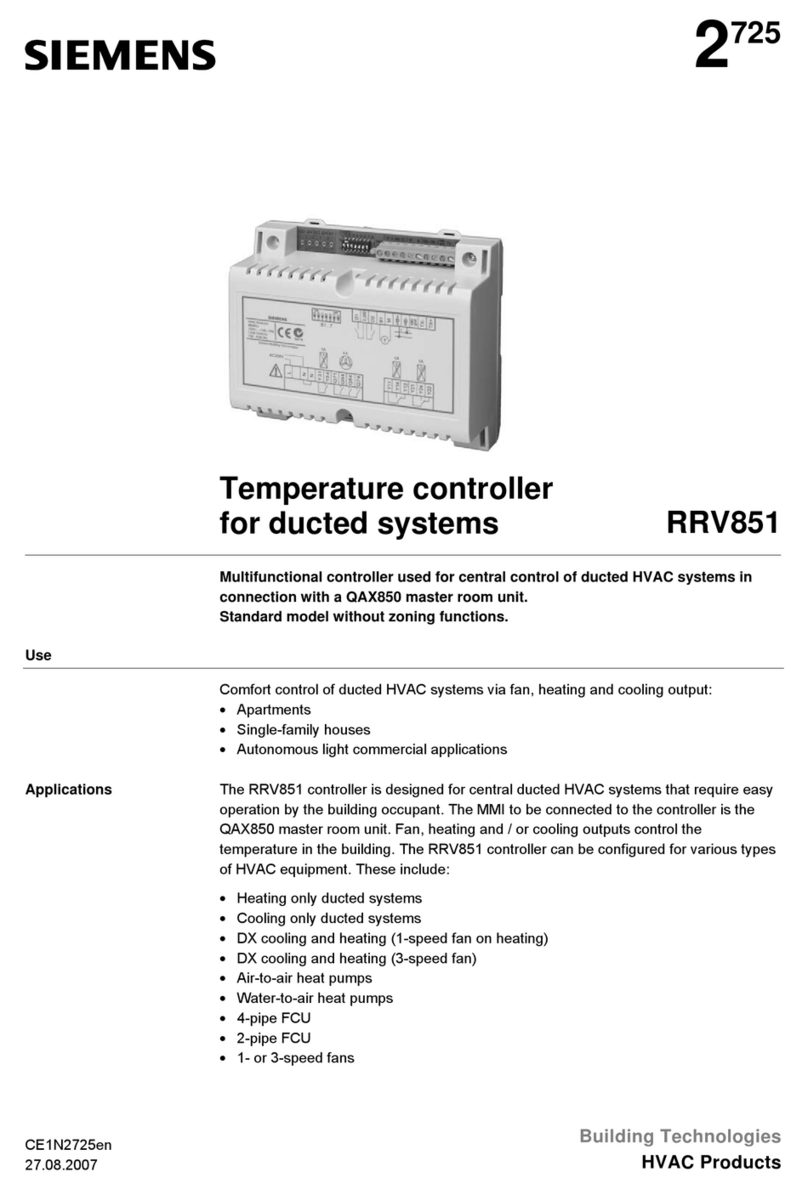
Siemens
Siemens RRV851 quick start guide
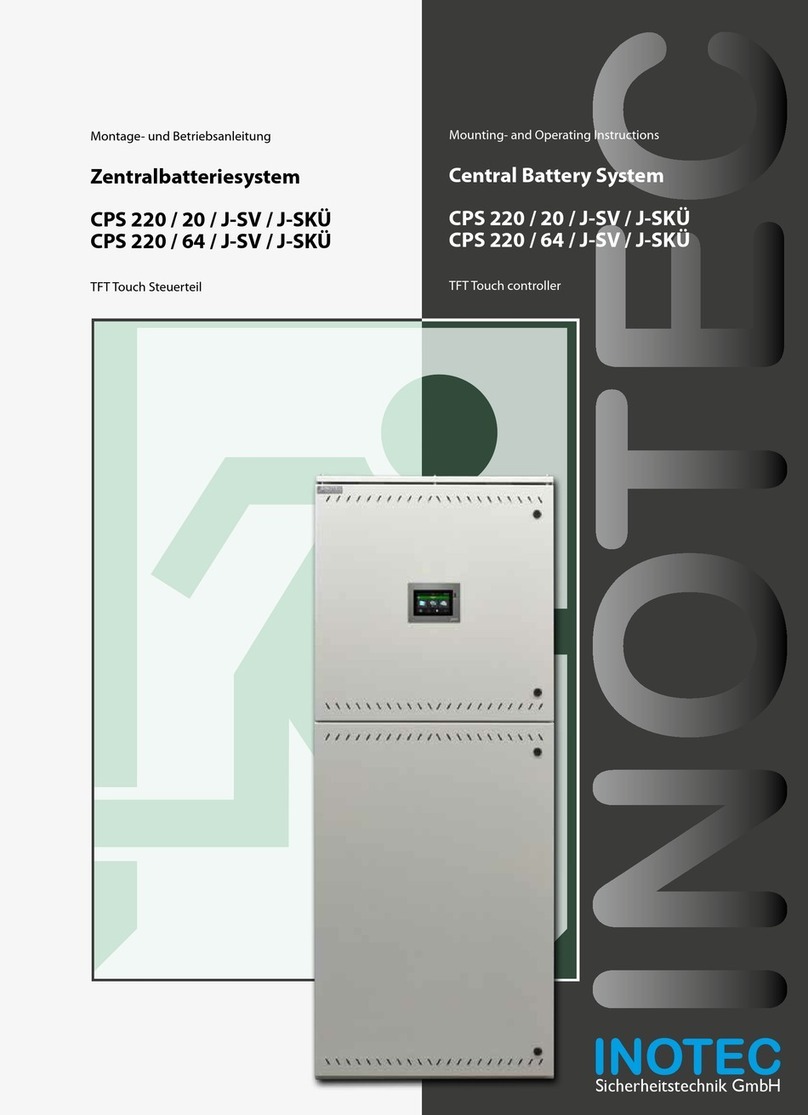
InoTec
InoTec CPS 220/20/J-SV/J-SKU Mounting and operating instructions
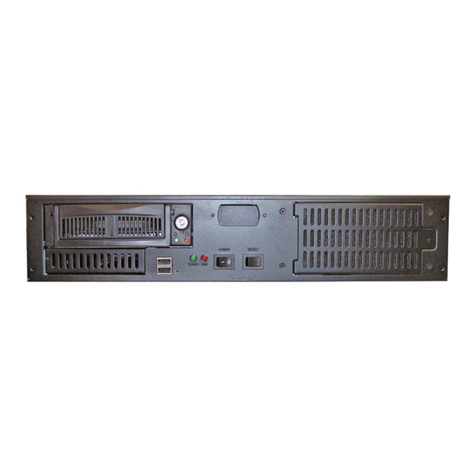
Adaptive
Adaptive 1109502601SP quick start guide

Honeywell
Honeywell Sieger System 57 quick start guide
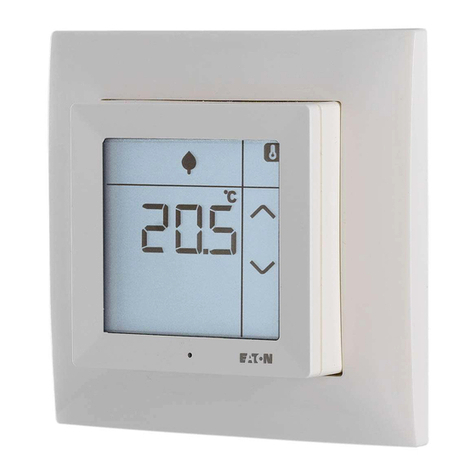
Eaton
Eaton xComfort Room Controller Touch user manual
